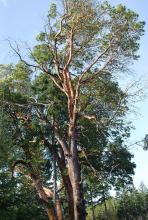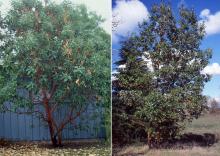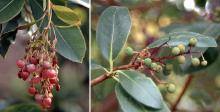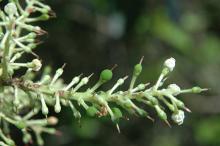Arbutus menziesii
Common name:
Pacific Madrone
Pacific Madrona
Pronunciation:
ar-BU-tus men-ZEE-see-i
Family:
Ericaceae
Genus:
Type:
Broadleaf
Native to (or naturalized in) Oregon:
Yes
- Broad-leaved evergreen tree, 20-65 ft (6-20 m), mature bark reddish brown, exfoliating, bark on stems smooth and reddish. Leaves alternate, simple, oval, broad, 3.5-10 cm long x 4-7.5 cm wide, thick and leathery, base subcordate to broad-cuneate, apex obtuse or somewhat acute, margin entire, lustrous dark green above. Flowers white, urn-shaped, about 1 cm long. Fruit ellipsoid or obovoid, orange-red, 10-13 mm.
- Sun to part shade, sheds leaves and bark irregularly so rather messy in the garden. Seedlings are difficult to transplant unless very young, they should not be much more than a foot (30 cm) tall.
- Hardy to USDA Zone (7)8 Native to Pacific Northwest and California, narrow belt along the Pacific Ocean.
- menziesii: after Archibald Menzies, Scottish physician and naturalist who collected in the Pacific Northwest.
- Common name: Madrone or Madrona are derived from the Spanish name, Madroño, the name for the closely related Strawberry Tree (Arbutus unedo) of the Mediterranean region. Father Juan Crespi (1721-1782), a Spanish missionary, in 1769 during an expedition in California discovered trees that he thought were similar, albeit with smaller fruit, to the Madroño of Spain.











